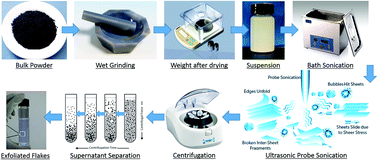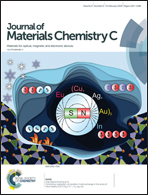Liquid-assisted exfoliation of 2D hBN flakes and their dispersion in PEO to fabricate highly specific and stable linear humidity sensors†
Abstract
A highly specific and sensitive linear humidity sensor has been fabricated using a dispersion of 2D hexagonal boron nitride (hBN) flakes in polyethylene oxide (PEO). Bulk hBN powder was exfoliated via liquid-assisted mechanical exfoliation to achieve few-layered 2D nano-flakes with thicknesses in the range of 3–4 nm. PEO was used as the polymer matrix to disperse the hBN flakes evenly throughout the suspension. An interdigitated transducer (IDT) electrode pair fabricated via reverse off-set printing using silver nanoparticles ink (AgNPs) on a piezoelectric LiNbO3 substrate serves as the transducing portion of the sensor. Electrohydrodynamic atomization was used to spray a uniform thin film of the active composite material onto the sensor electrodes. All the fabrication methods used are compatible with printed electronics approaches and are suitable for mass production. The sensors show excellent stability for up to 40 days of testing. The sensitivity of the near-linear sensors was ∼24 kΩ/%RH, which is better than most of the previously reported studies. The sensors showed response and recovery times of 2.6 s and 2.8 s, respectively. The selectivity of the sensors was tested by exposing the sensors to O2, N2, and CH4 gases in addition to humidity and the results showed no effect of the other gases on the sensors output. The fabricated sensors based on the 2D hBN/polymer composite can be employed in high-end target specific applications requiring accurate and high performance humidity sensors.



 Please wait while we load your content...
Please wait while we load your content...